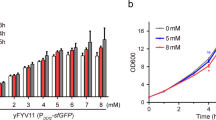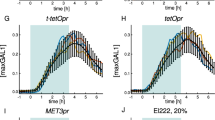Abstract
Temperature–regulated hybrid yeast promoters were constructed in which synthetic MATα2 operator sequences were inserted into the strong promoters for the constitutive TPI1 (triose phosphate isomerase) gene and the glucose–repressible ADH2 (alcohol dehydrogenase) gene. These variant promoters were joined to the E. coli lacZ gene in yeast vectors and transformed into mating–type a yeast strains bearing a temperature–sensitive sir3–8 mutation. At the permissive temperature (25°C), the sir3–8 product represses the silent mating–type loci HMRa and HMLα, so that the MATα2 represser protein is not synthesized by HMLα and β–galactosidase is produced at high levels. At the restrictive temperature (35°C), MATα2 repressor is made and represses transcription of lacZ. At temperatures between 25°C and 35°C, intermediate levels of β–galactosidase are made. Thus, the level of heterologous product can be altered by adjusting the temperature.
This is a preview of subscription content, access via your institution
Access options
Subscribe to this journal
Receive 12 print issues and online access
$209.00 per year
only $17.42 per issue
Buy this article
- Purchase on Springer Link
- Instant access to full article PDF
Prices may be subject to local taxes which are calculated during checkout
Similar content being viewed by others
References
Johnson, A.D. and Herskowitz, I. 1985. A represser (MATα2 product) and its operator control expression of a set of cell type specific genes in yeast. Cell 42:237–247.
Miller, A.M., MacKay, V.L., and Nasmyth, K. 1985. Identification and comparison of two sequence elements that confer cell-type transcription in yeast. Nature 314:598–603.
Kronstad, J.W., Holly, J.A., and MacKay, V.L. 1987. A yeast operator overlaps an upstream activation site. Cell 50:369–377.
Bender, A. and Sprague.Jr., G.F. 1987. MATα1 protein, a yeast transcription activator, binds synergestically with a second protein to a set of cell-type-specific genes. Cell 50:681–691.
Manney, T.R., Jackson, P., and Meade, J. 1983. Two temperature-sensitive mutants of Saccharomyces cerevisiae with altered expression of mating-type functions. J. Cell Biol. 96:1592–1600.
Hartig, A., Holly, J., Saari, G., and MacKay, V.L. 1986. Multiple regulation of STE2, a mating-type-specific gene of Saccharomyces cerevisiae. Mol. Cell. Biol. 6:2106–2114.
Herskowitz, I. and Oshima, Y. 1981. Control of cell type in Saccharomyces cerevisiae: Mating type and mating-type inter-conversion, p. 181–209. In: The Molecular Biology of the Yeast Saccharomyces: Life Cycle and Inheritance. J. N. Strathern, E. W. Jones, and J. R. Broach (Eds.). Cold Spring Harbor, New York.
Rine, J. and Herskowitz, I. 1987. Four genes responsible for a position effect on expression from HML and HMR in Saccharomyces cerevisiae. Genetics 116:9–22.
Alber, T. and Kawasaki, G. 1982. Nucleotide sequence of the triose phosphate isomerase gene of Saccharomyces cereiitsiae. J. Mol. Appl. Genet. 1:419–434.
Shuster, J., Yu, J., Cox, D., Chan, R.V.L., Smith, M. and Young, E. 1986. ADR1-mediated regulation of ADH2 requires an inverted repeat sequence. Mol. Cell. Biol. 6:1894–1902.
Beier, D.R. and Young, E.T. 1982. Characterization of a regulatory region upstream of the ADR2 locus of S. cerevisiae. Nature 300:724–728.
Kilmartin, J.V. and Adams, A.E.M. 1983. Structural rearrangements of tubulin and actin during the cell cycle of the yeast Saccharomyces. J. Cell Biol. 98:922–933.
Schultz, L.D., Tanner, J., Hofmann, K.J., Emini, E.A., Condra, J.H., Jones, R.E., Kieff, E., and Ellis, R.W. 1987. Expression and secretion in yeast of a 400 kDa envelope glycoprotein derived from Epstein-Barr virus. Gene 54:113–123.
Kramer, R.A., DeChiara, T.M., Schaber, M.D., and Hilliker, S. 1984. Regulated expression of a human interferon gene in yeast: Control by phosphate concentration or temperature. Proc. Natl. Acad. Sci. USA 81:367–370.
Brake, A.J., Merryweather, J.P., Coit, D.G., Heberlcin, V.A., Masiarz, F.R., Mullenbach, G.T., Urdea, M.S., Valenquela, P., and Barr, P.J. 1984. α-Factor-directed synthesis and secretion of mature foreign proteins in Saccharomyces cerevisiae. Proc. Natl. Acad. Sci. USA 81:4642–4646.
Ernst, J.F. 1986. Improved secretion of heterologous proteins by Saccharomyces cerevisiae: Effects of promoter substitution in alpha-factor fusions. DNA 5:483–491.
Smith, R.A., Duncan, M.J. and Moir, D.T. 1985. Heterologous protein secretion from yeast. Science 229:1219–1224.
Maniatis, T., Fritsch, E.F., and Sambrook, J. 1982. Molecular cloning: A laboratory manual. Cold Spring Harbor Laboratory, Cold Spring Harbor, NY.
Sinha, N.D., Biernat, J. McManus, J., and Koster, H. 1984. Polymer support oligonucleotide synthesis XVIII: Use of bcta-cyanoethyl-n, n-dialkylamino-/n-morpholino phosphoramidite for synthesis of DNA fragments simplifying deprotection and isolation of the final product. Nucl. Acid Res. 12:4539–4557.
Sanger, F., Nicklens, S., and Coulson, A.R. 1977. DNA sequencing with chain-terminating inhibitors. Proc. Natl. Acad. Sci. USA 74:5463–5467.
Guarente, L. and Ptashne, M. 1981. Fusion of Escherichia coli lacZ to the cytochrome c gene of Saccharomyces cerevisiae. Proc. Natl. Acad. Sci. USA 78:2199–2203.
Beggs, J.D. 1978. Transformation of yeast by a replicating hybrid plasmid. Nature 275:104–108.
Miller, J. 1972. Experiments in Molecular Genetics. Cold Spring Harbor Laboratory, Cold Spring Harbor, NY.
Maccecchini, M.-L., Rudin, Y., Blobel, G., and Schatz, G. 1979. Import of proteins into mitochondrially made F-1 ATPase subunits in yeast Proc. Natl. Acad. Sci. USA 76:343–347.
Author information
Authors and Affiliations
Rights and permissions
About this article
Cite this article
Sledziewski, A., Bell, A., Kelsay, K. et al. Construction of Temperature–Regulated Yeast Promoters Using the Matα2 Repression System. Nat Biotechnol 6, 411–416 (1988). https://doi.org/10.1038/nbt0488-411
Received:
Accepted:
Issue Date:
DOI: https://doi.org/10.1038/nbt0488-411



